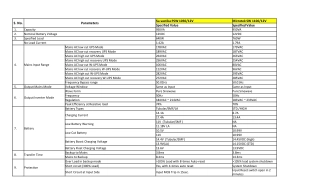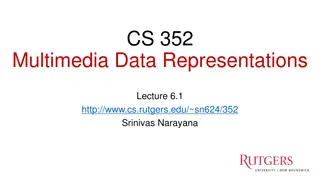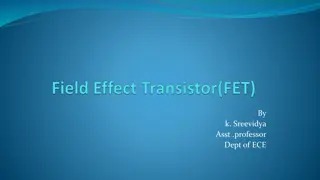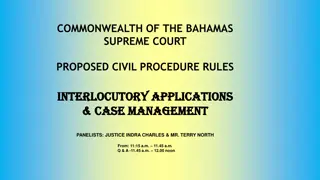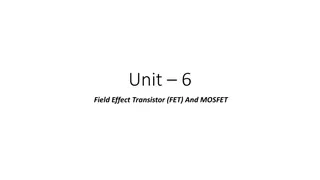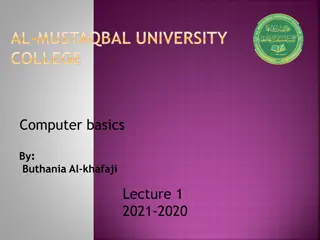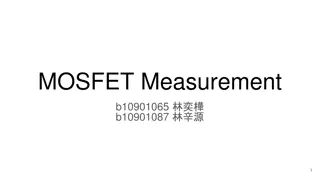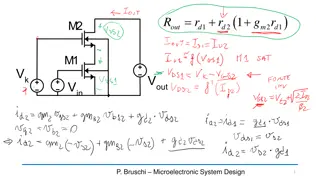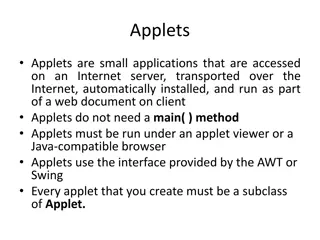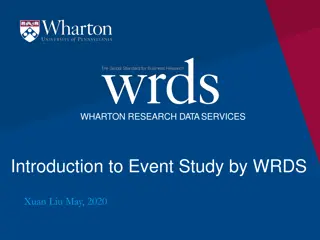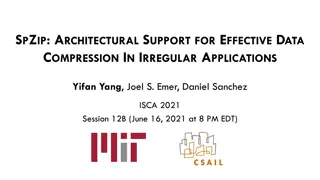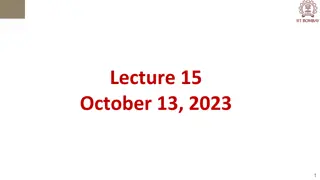Understanding MOSFET: Basics and Applications
MOSFET, or Metal Oxide Semiconductor Field Effect Transistor, is a key component in modern electronics. This presentation by Poonam Sharma covers the working principles, types, and applications of MOSFETs. Exploring the insulated gate feature, voltage control, and construction details, it explains how MOSFETs function as switches and amplifiers. Depletion and enhancement types, along with their symbols and construction, are highlighted, providing insights into the versatile use of MOSFETs in various circuits.
Uploaded on Oct 11, 2024 | 0 Views
Download Presentation

Please find below an Image/Link to download the presentation.
The content on the website is provided AS IS for your information and personal use only. It may not be sold, licensed, or shared on other websites without obtaining consent from the author. Download presentation by click this link. If you encounter any issues during the download, it is possible that the publisher has removed the file from their server.
E N D
Presentation Transcript
MOSFET POWERPOINT PRESENTATION BY:- POONAM SHARMA LECTURER ELECTRICAL GP MANESAR
The MOSFET there is another type of Field Effect Transistor available whose Gate input is electrically insulated from the main current carrying channel and is therefore called an Insulated Gate Field Effect Transistor. The most common type of insulated gate FET which is used in many different types of electronic circuits is called the Metal Oxide Semiconductor Field Effect Transistor MOSFET for short.
The IGFET or MOSFET is a voltage controlled field effect transistor that differs from a JFET in that it has a Metal Oxide Gate electrode which is electrically insulated from the main semiconductor n-channel or p-channel by a very thin layer of insulating material usually silicon dioxide, commonly known as glass. This ultra thin insulated metal gate electrode can be thought of as one plate of a capacitor. The isolation of the controlling Gate makes the input resistance of the MOSFET extremely high way up in the Mega-ohms ( M ) region thereby making it almost infinite. As the Gate terminal is isolated from the main current carrying channel NO current flows into the gate and just like the JFET, the MOSFET also acts like a voltage controlled resistor were the current flowing through the main channel between the Drain and Source is proportional to the input voltage. Also like the JFET, the MOSFETs very high input resistance can easily accumulate large amounts of static charge resulting in the MOSFET becoming easily damaged unless carefully handled or protected.
MOSFETs are available in two basic forms: Depletion Type the transistor requires the Gate-Source voltage, ( VGS ) to switch the device OFF . The depletion mode MOSFET is equivalent to a Normally Closed switch. Enhancement Type the transistor requires a Gate-Source voltage, ( VGS ) to switch the device ON . The enhancement mode MOSFET is equivalent to a Normally Open switch.
The symbols and basic construction for both configurations of MOSFETs are shown below.
The construction of the Metal Oxide Semiconductor FET is very different to that of the Junction FET. Both the Depletion and Enhancement type MOSFETs use an electrical field produced by a gate voltage to alter the flow of charge carriers, electrons for n-channel or holes for P- channel, through the semiconductive drain-source channel. The gate electrode is placed on top of a very thin insulating layer and there are a pair of small n-type regions just under the drain and source electrodes. We saw in the previous tutorial, that the gate of a junction field effect transistor, JFET must be biased in such a way as to reverse-bias the pn-junction. With a insulated gate MOSFET device no such limitations apply so it is possible to bias the gate of a MOSFET in either polarity, positive (+ve) or negative (-ve). This makes the MOSFET device especially valuable as electronic switches or to make logic gates because with no
Depletion-mode MOSFET The Depletion-mode MOSFET, which is less common than the enhancement mode types is normally switched ON (conducting) without the application of a gate bias voltage. That is the channel conducts when VGS= 0 making it a normally-closed device. The circuit symbol shown above for a depletion MOS transistor uses a solid channel line to signify a normally closed conductive channel. For the n-channel depletion MOS transistor, a negative gate-source voltage, -VGSwill deplete (hence its name) the conductive channel of its free electrons switching the transistor OFF . Likewise for a p-channel depletion MOS transistor a positive gate-source voltage, +VGSwill deplete the channel of its free holes turning it OFF . In other words, for an n-channel depletion mode MOSFET: +VGSmeans more electrons and more current. While a -VGSmeans less electrons and less current. The opposite is also true for the p-channel types. Then the depletion mode MOSFET is equivalent to a normally-closed switch.
Depletion-mode N-Channel MOSFET and circuit Symbols The depletion-mode MOSFET is constructed in a similar way to their JFET transistor counterparts were the drain- source channel is inherently conductive with the electrons and holes already present within the n-type or p-type channel. This doping of the channel produces a conducting path of low resistance between the Drain and Source with zero Gate bias.
Enhancement-mode MOSFET The more common Enhancement-mode MOSFET or eMOSFET, is the reverse of the depletion-mode type. Here the conducting channel is lightly doped or even undoped making it non-conductive. This results in the device being normally OFF (non-conducting) when the gate bias voltage, VGSis equal to zero. The circuit symbol shown above for an enhancement MOS transistor uses a broken channel line to signify a normally open non- conducting channel. For the n-channel enhancement MOS transistor a drain current will only flow when a gate voltage ( VGS) is applied to the gate terminal greater than the threshold voltage ( VTH) level in which conductance takes place making it a transconductance device.
WORKING OF N-TYPE MOSFET The application of a positive (+ve) gate voltage to a n-type eMOSFET attracts more electrons towards the oxide layer around the gate thereby increasing or enhancing (hence its name) the thickness of the channel allowing more current to flow. This is why this kind of transistor is called an enhancement mode device as the application of a gate voltage enhances the channel. Increasing this positive gate voltage will cause the channel resistance to decrease further causing an increase in the drain current, IDthrough the channel. In other words, for an n- channel enhancement mode MOSFET: +VGSturns the transistor ON , while a zero or - VGSturns the transistor OFF . Thus the enhancement-mode MOSFET is equivalent to a normally-open switch. The reverse is true for the p-channel enhancement MOS transistor. When VGS= 0 the device is OFF and the channel is open. The application of a negative (-ve) gate voltage to the p-type eMOSFET enhances the channels conductivity turning it ON . Then for an p-channel enhancement mode MOSFET: +VGSturns the transistor OFF , while - VGSturns the transistor ON .
Enhancement-mode N-Channel MOSFET and Circuit Symbols
Enhancement-mode MOSFETs make excellent electronics switches due to their low ON resistance and extremely high OFF resistance as well as their infinitely high input resistance due to their isolated gate. Enhancement-mode MOSFETs are used in integrated circuits to produce CMOS type Logic Gates and power switching circuits in the form of as PMOS (P-channel) and NMOS (N-channel) gates. CMOS actually stands for Complementary MOS meaning that the logic device has both PMOS and NMOS within its design.


